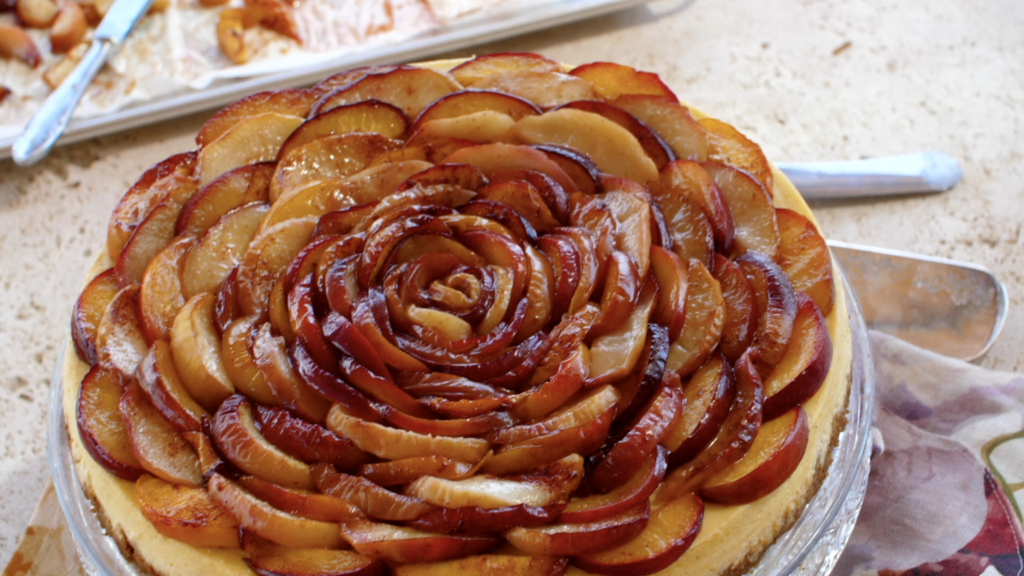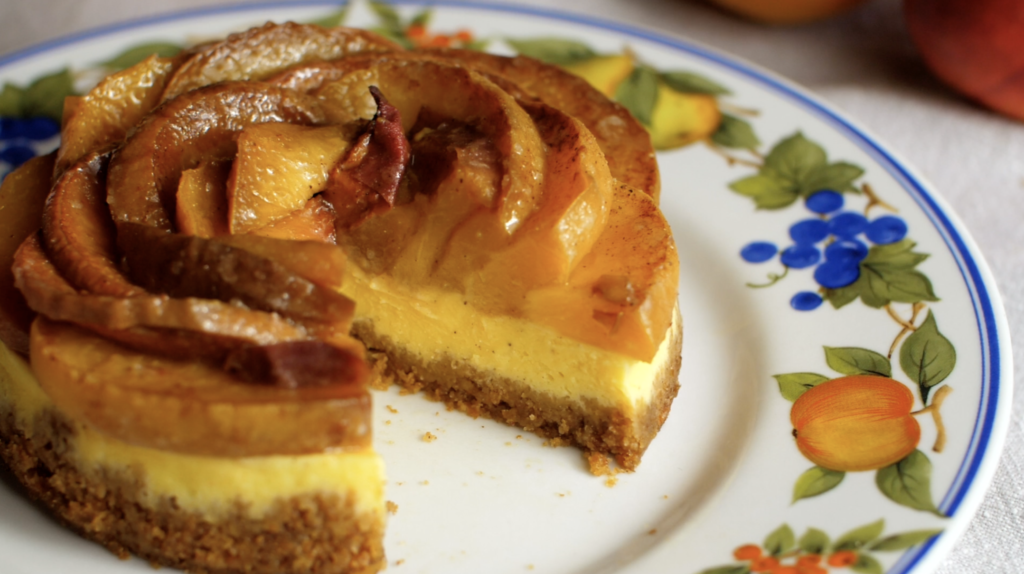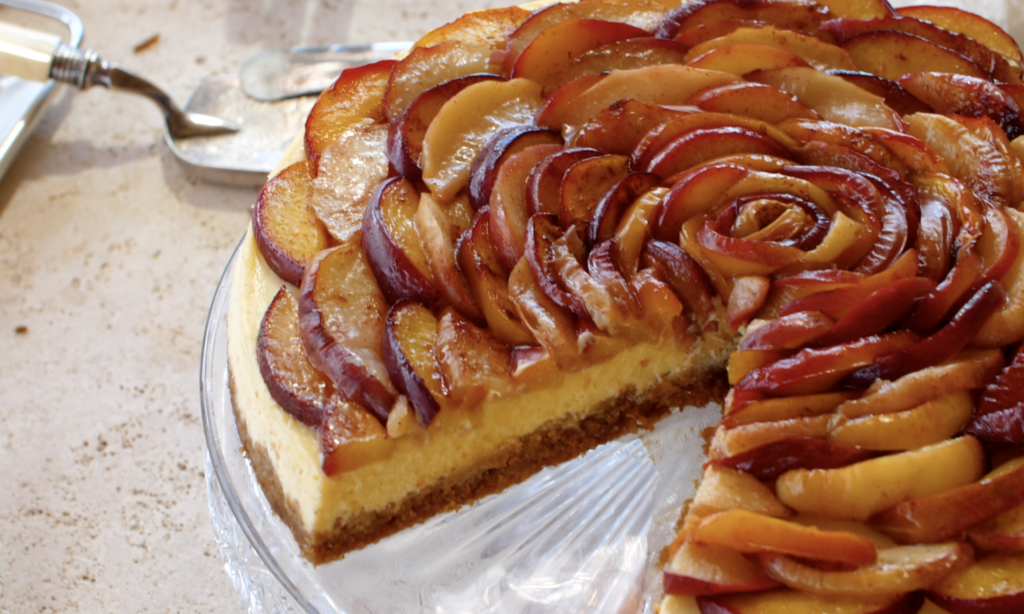
I feel like cheesecake is such an internationally beloved dessert that you will certainly have your own favourite recipe. However, if you’d like to try something that feels a little lighter and summery, then this fruit-topped version with a little yoghurt could become your new favourite.
I love the texture of baked cheesecake but I think sometimes a high cheesecake can be slightly one-dimensional because it takes forever to arrive at the crust or the topping and guests can decline dessert because a giant slice of traditional cheesecake can appear quite heavy and rich. So this is a relatively low cheesecake but it certainly still delivers on richness and flavour. I like the addition of yoghurt because it makes the texture a little less heavy and provides a subtle bit of tang. As you can see in the video, I made this twice on camera to double check the quantities work in a 26cm pan and also in eight mini cake pans. Don’t worry too much if your springform pan is smaller or larger than 26cm. It’s quite easy to just extend the crust by adding another 150grams of biscuits and a little more butter. There’s no real baking science going on with the crust so feel free to modify the quantities if you feel you would like crust up the sides. The filling didn’t arrive to the top of the pan so if you are working with one pan slightly smaller than 26cm you will still be able to fit the filling with these measurements.
If you can’t find ripe peaches where you are, this could work equally well with any summer fruit like apricots, nectarines, figs, plums etc.
REMEMBER, the most important thing is to exercise a little forward thinking and restraint and don’t let anyone eat your cheesecake until it has rested in the fridge overnight.

INGREDIENTS:
350 grams biscuits/cookies
150 grams butter, melted, for crust
40 grams butter for greasing pans
100 grams butter, melted, for peaches
2 tablespoons brown sugar for crust
1/4 cup brown sugar for peaches
3 shakes of cinnamon for crust
3 shakes of cinnamon for filling
3 shakes of cinnamon for peaches
500 grams cream cheese
1 cup caster sugar for filling
- I know this sugar isn’t as common in the US as it is in other countries. It’s essentially a fine white sugar that is somewhere between granulated and confectioners’ sugar. I just like how it dissolves into the cream cheese but you could use granulated sugar.
- Also, if you like a really sweet cheesecake, I would add another 1/4 of a cup of sugar.
1 medium lemon (for zest and three tablespoons of lemon juice)
1 teaspoon vanilla extract
2 shakes of cinnamon
2 tablespoons cornstarch
4 eggs
300 grams natural sugar-free yoghurt
5-7 peaches, depending on how tightly you decorate your cake

METHOD:
- Preheat oven to 180C or 350F for the crust and take cream cheese, eggs and yoghurt out of the fridge to bring them a little closer to room temperature when we do the filling later.
- Cut a circle (or circles) of baking paper and stick it to a springform pan with a little smudge of butter in the centre. I used eight little pans the first time I filmed and a 26cm pan the second time. I turn the base of the springform pan upside down so that the bottom of my cheesecake is nice and flat and easy to remove.
- Crush your biscuits/cookies by putting them in a plastic bag, covering with a tea towel so you don’t rip the bag and then bashing with a rolling pin, a can, or the base of a caffettiera as I did in the video. You want them to be quite fine but you can break down any stubborn pieces with your fingers later.
- Add cinnamon and sugar and then gradually add as much of the melted butter you need until it feels like the mixture will make a little compact ball when you squeeze some by making a fist. If it just falls away into crumbs without any imprint of your hand, then add more butter.
- Scatter the crust mixture into the pan and then press down firmly with your fingertips so that all crumbs are compact and even.
- Place the crust into the oven for about 10 minutes or until it is lightly golden. This isn’t crucial so don’t worry if you undercook it. The butter will firm up in the fridge overnight.
- Let’s start the filling! Gradually add the sugar to the softened cream cheese in a big bowl, beating with a whisk or a big wooden spoon.
- Check on the crust – don’t let it burn! Take it out to cool when golden because we don’t want to put the filling in until the cheesecake pan has cooled.
- Now back to the filling. Add zest of the whole lemon, juice of half the lemon, cinnamon, vanilla and sift in the cornstarch. Mix until fully combined.
- Gradually add the eggs, one at a time, beating briefly after each one. Try not to over-mix at this point.
- Is your oven still on from the crust? Just take the heat down a little. Some recipes advise to cook on a medium high heat for the first 20 mins and then turn it down but I find I get distracted so I’d prefer to just cook on a slightly lower heat of 150C or 300F.
- Now add the yoghurt and mix gently until just combined.
- Put a small saucepan of water on the stove to boil.
- Put aluminium foil on the pan (or pans) with the crust to protect it from the water bath we’re about to do and make sure your cheesecake pan is on an oven tray with sides about two fingers high. Grease the inside of the pan sides with butter.
- Pour the filling into the cooled pan (or pans) and just shake the pan from side to side a little to make sure no bubbles are trapped inside and the batter settles.
- Now place in the oven for 45-60 minutes for the single cheesecake or 30-40 minutes for the individual cheesecakes. Once it’s in the oven with the door still open, carefully pour the hot water around the pan, creating a water bath that will keep the oven humid for extra creamy texture. It’s important not to overcook cheesecake and even if it seems very wobbly, remember it will be transformed by sleeping in the fridge to set overnight so don’t be afraid to turn off the oven when the edges are cooked and have come away from the sides of the pan but the centre is still a little bit soft and wobbly. You should see that the entire surface of the cheesecake is set even though the centre might jiggle a little.
- At this point, with the oven turned off, place a wooden spoon in the oven door so that it’s ajar and letting air cool the cheesecake down gradually. It can crack if you take it immediately from the hot oven to kitchen bench at room temperature straight away. Leave it like this in the oven with the door ajar for an hour.
- Now remove the cheesecake from the oven and the water bath and aluminium foil, carefully run a knife around the edges of the cake and leave for another hour on the kitchen bench, covered from flies (there are so many in Tuscany right now!) with a tea towel (instead of a bowl or plastic that would result in condensation).
- When the cheesecake is cooled, wrap in cling film and place in the fridge for 4 hours or preferably, overnight.
- The Peach Topping! On the day you plan to serve the cheesecake, preheat your oven to 180C or 350F and cut peaches into thin slices. If they are very ripe, I suppose you might want to go for slightly thicker slices in case they become too mushy to handle when roasted. Arrange them on a large tray with baking paper.
- Sprinkle brown sugar and cinnamon over the fruit and top with melted butter.
- Roast in the oven for 10-15 minutes or until you’re happy with their aroma and colour.
- I transfer them to a plate so they will cool faster when out of the oven so they’re easier to handle when decorating.
- Now take your cheesecake from the fridge and enjoy making pretty patterns or simply pile the peaches in the centre and call it ‘rustic’. ?